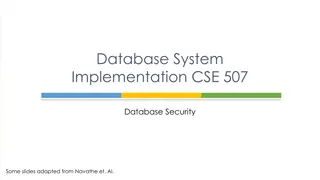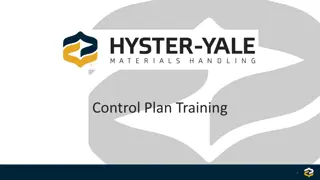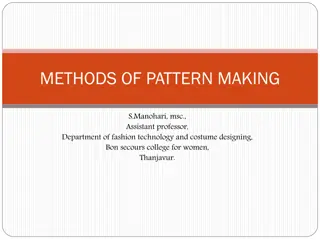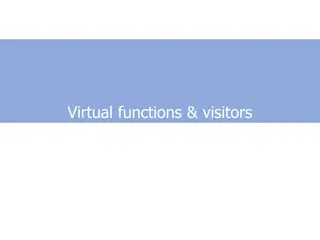Pattern-Based Access Control in Decentralised Collaboration Environment - LDAC 2020
Explore the LDAC 2020 research on pattern-based access control in a decentralised collaboration environment, focusing on decentralised social applications, Solid project, and the (Con)Solid POD concept. The study delves into agents storing data on personal PODs, distributed building projects, and the role of LDAC in managing complex stakeholder networks in accessing heterogeneous data.
Download Presentation

Please find below an Image/Link to download the presentation.
The content on the website is provided AS IS for your information and personal use only. It may not be sold, licensed, or shared on other websites without obtaining consent from the author. Download presentation by click this link. If you encounter any issues during the download, it is possible that the publisher has removed the file from their server.
E N D
Presentation Transcript
PATTERN-BASED ACCESS CONTROL IN A DECENTRALISED COLLABORATION ENVIRONMENT LDAC 2020 JEROEN WERBROUCK AUTHORS : Jeroen Werbrouck - Ruben Taelman - Ruben Verborgh - Pieter Pauwels - Jakob Beetz - Erik Mannens
INTRODUCTION M. Sc. in Engineering: Architecture (Ghent University 2018) BIM4Ren / LBDserver (2018-2019) FWO researcher (2019- ) Erik Mannens, Jakob Beetz, Pieter Pauwels, Ruben Verborgh Ghent University / RWTH Aachen University
THE SOLID PROJECT Solid (derived from "social linked data") is a proposed set of conventions and tools for building decentralized social applications based on Linked Data principles. Solid is modular and extensible and it relies as much as possible on existing W3C standards and protocols. [https://solid.mit.edu] [1] i https://solidproject.org/
THE SOLID PROJECT Agents store data on a personal POD, either self-hosted or hosted by a provider Identification by webID* Linked Data Platform (LDP)** specification Web application SDK PODs organised as a folder structure Structural Office HVAC Office Architect Office Geospatial dataset [2, 3] i *https://www.w3.org/wiki/WebID || **https://www.w3.org/TR/ldp/
THE CONSOLID PROJECT Solid for Construction Stakeholder PODs & Project metadata POD & open data LBD bots acting on decentralised models Distributed building projects EXTENDED DISTRIBUTED BUILDING MODEL ACCESSIBILITY CHECKER Owner Architect Government Geospatial Structure Surveyor NEIGHBOURHOOD REASONER FM Product HVAC Consultant COLLISION CHECKER DISTRIBUTED BUILDING MODEL
WHAT IS A (CON)SOLID POD? https://bob.his-office.org/ GEOMETRY.STEP .ACL PROFILE CARD.TTL STRUCTURE_LBD.TTL SOME_IMG.JPG PUBLIC ORIGINAL.IFC PRIVATE SHAPES.TTL CONSOLID PROJECT_1 INDEX.TTL INBOX PROJECT_2 .ACL NANOCREDENTIALS
PBAC Complex networks of stakeholders, subcontractors, employees Accessing distributed and heterogeneous data ? Pattern-based access control Properties of the requesting actor Properties of the requested resource Other contextual information LDAC 2020
REQUIREMENTS Authentication Authorisation Immutable statements Trust Rules and validation Connecting framework WebID Web Access Control (WAC) Nanopublications Digital signatures SHACL PBAC
WEB-ID ID: DENOTES CARD: DESCRIBES Identification of actors/bots/ using a personal URL Solid Coupled with a data POD Card: Basic information about the actor E.g.: https://jwerbrouck.consolidproject.be/profile/card#me
WAC W3C / Solid: Web Access Control* ACL resource: RDF (Turtle) document Access Control List Folder/Resource specific Identification by WebID (individuals or groups) WebID-OIDC** Access modes: Read, Write, Append, Control Granularity: LDP resource (image, named graph, ) i *https://github.com/solid/web-access-control-spec || **https://github.com/solid/webid-oidc-spec
NANOPUBLICATIONS Fixed set of named graphs (TRIG)* ASSERTION PROVENANCE PUBLICATION INFO The actual statements Explains why Adds authority layer Freeze with digital signature and Trusty URIs** Provenance contains signature and authorship URI of the Nanopublication contains hash of content In context of certificates: Nanocredentials ? [4] i T. Kuhn et al., 2013 & 2014 *http://nanopub.org || **http://trustyuri.net
NANOPUBLICATIONS TRUSTY URI (ARTIFACT) MAKES THE PUBLICATION IMMUTABLE ASSERTION EXPLICIT STATEMENTS ABOUT A CERTAIN ACTOR (WEB ID) PROVENANCE WHY THE ASSERTION IS TRUE PUBLICATION INFO PUBLIC KEY EXPRESSED IN WEB ID SIGNING AUTHORITY
SHACL SHApes Constraint Language* Closed-world validation of RDF statements If it is not explicitly mentioned, it is not true Shapes describe the requirements a resource should fulfil to be valid (in context of the shape) EXAMPLE SHAPE 2 : A visitor must be a contractor within the project pbac:visitor changes to the WebID of the visitor at runtime EXAMPLE SHAPE 1 a bot:Site instance must have exactly 1 zero point i *https://www.w3.org/TR/shacl/
PBAC FRAMEWORK Patterns in the Nanopublications should fit the patterns expressed in the SHACL shapes Extends the ACL specification pbac:DynamicRule identifies the access rule pbac:hasShape refers to the shape template pbac:hasTrustedAuthority refers to the webID of the actor(s) that signed the Nanocredential VANILLA ACL PBAC EXTENSION
USE CASE PROJECT POD ACL: all stakeholders and occupants ACL: only #me and people assigned to project tasks 1, 3, or 4 Architect Struc. Eng. ? Query HVAC consultant Electr. consultant employee ACL: only #me and direct project stakeholders ACL: only #me, the architectural office and the structural engineering office i Use case: iGent Tower, Ghent, Belgium
USE CASE: DELEGATION PROJECT POD 1 Architect Office 1 BASED UPON NP 2 HVAC consultant SIGNING NP BY PROJECT 3 SIGNING ASSERTION BY ARCH employee Only one of the signing authorities can generate the trusty URI (project WebID satellite Main trusted authority) !
USE CASE FETCHING NECESSARY NANOPUBLICATIONS: 1 HVAC employee Authenticates with WebID (browser) Dashboard APP HVAC office POD* (GET) NP: PROJECT STAKEHOLDERSHIP Resource: NP PBAC extension HEADERS: nanopublication1: Visitor must be employee of HVAC office trustedAuthority: hvacOffice#me assertion: #me employeeOf hvacOffice#me pubinfo: signed by hvacOffice#me VALID: OK (RESPONSE) NP: PROJECT STAKEHOLDERSHIP HEADERS: nanopublication2: assertion: hvacOffice#me contractorOf theProject#me hvacOffice#me hasTask task:Task3 pubinfo: signedBy architect#me approvedBy project#me i *ALTERNATIVE: direct request to the project POD/API (both issuer and receiver keep a copy NP) project API as a proxy to the rest of the project
USE CASE 2 QUERY: Dashboard APP Struc. Eng. POD GET RESOURCE(S) OF INTEREST Resource: Structural model HEADERS: nanopublication1: assertion: #me employeeOf hvacOffice#me pubinfo: signedBy hvacOffice#me PBAC extension nanopublication2: Visitor must be employee of structure office OR be responsible for Tasks 1, 3 or 4. assertion: hvacOffice#me contractorOf theProject#me hvacOffice#me hasTask task:Task3 pubinfo: signedBy architect#me approvedBy theProject#me trustedAuthority: theProject#me VALID: OK RESPONSE: STRUCTURAL MODEL LBD E.g. query with Comunica* (SPARQL, GRAPHQL-LD ) i *ALTERNATIVE: direct request to the project POD/API (both issuer and receiver keep a copy NP) project API as a proxy to the rest of the project
RECAP Authentication Authorisation Immutable statements Trust Rules and validation Connecting framework WebID Web Access Control (WAC) Nanopublications Digital signatures SHACL PBAC
GENERALISATION OF PBAC AECO-specific implementation: Project WebID acts as the main trusted authority Chain discovery is bypassed if every NP is signed by Project WebID ALTERNATIVE: Project hierarchy may help in chain discovery General implementation: Chain discovery involving multiple actors in a non-hierarchical way? Publicness of shapes? Shape assertion relationship?
FUTURE WORK REMAINING QUESTIONS: General applicability? Contextual patterns (resource, task, current project phase )? Chain discovery and traversal? Maximise trust in the project WebID (who controls this POD?) Degree of centralisation? IMPLEMENTATION Improve checking and authorship verification functionality Employee delegation Shape or NP templating ConSolid Dashboard implementation Geometry linking (query via geometric UI)
THANK YOU This research is funded by the Research Foundation Flanders (FWO) in the form of a personal Strategic Basic (SB) Research grant (grant no. 1S99020N).
FURTHER READING Werbrouck, J., Pauwels, P., Beetz, J., van Berlo, L.: Towards a decentralised common data environment using linked building data and the solid ecosystem. In: 36th CIB W78 2019 Conference. pp. 113-123 (2019), https://biblio.ugent.be/publication/8633673. Oraskari, J., T rm , S.: Access control for web of building data: Challenges and directions. In: eWork and eBusiness in Architecture, Engineering and Construction: ECPPM 2016: Proceedings of the 11th European Conference on Product and Process Modelling (ECPPM 2016), Limassol, Cyprus, 7-9 September 2016. p. 45. CRC Press (2016), Kirrane, S., Mileo, A., Decker, S.: Access control and the resource description framework: A survey. Semantic Web 8(2), 311-352 (2017), http://www.semantic-web-journal.net/system/files/swj1280.pdf. Kuhn, T., Barbano, P.E., Nagy, M.L., Krauthammer, M.: Broadening the scope of nanopublications. In: Extended Semantic Web Conference. pp. 487-501. Springer (2013), https://link.springer.com/content/pdf/10.1007/978-3-642-38288-8_33.pdf. Kuhn, T., Dumontier, M.: Trusty uris: Veriable, immutable, and permanent digital artifacts for linked data. In: European semantic web conference. pp. 395-410. Springer (2014), https://arxiv.org/pdf/1401.5775.pdf. IMAGE SOURCES: [1] https://solid.mit.edu/ [2] https://ruben.verborgh.org/ [3] https://www.slideshare.net/berlotti/bim-bots [4] http://nanopub.org/























